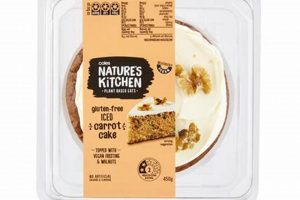A plant-based baked good relies on ingredients that exclude any animal products, such as eggs, dairy, or honey. This type of confection typically uses alternative binding and leavening agents to achieve a light and airy texture comparable to conventional versions. For example, applesauce or mashed bananas might substitute for eggs, while plant-based milk and oil replace dairy butter.
Catering to dietary restrictions and ethical concerns, this style of baking offers a wide appeal. Its increasing popularity reflects a growing awareness of sustainable food practices and the health benefits associated with plant-based diets. Historically, adapting standard recipes to exclude animal products has presented unique challenges, requiring innovative approaches to maintain desirable texture and flavor profiles.
The following sections will detail various techniques employed to create exceptional examples of this dessert, exploring the crucial role of ingredients and baking methods in achieving optimal results. Discussions will encompass considerations for gluten-free variations, flavor pairings, and decorative techniques suitable for enhancing the final product.
Crafting the Ideal Plant-Based Confection
Achieving desirable results in plant-based baking necessitates careful attention to ingredient selection and preparation techniques. The following recommendations aim to optimize the final product’s texture, flavor, and structural integrity.
Tip 1: Hydrate Chia or Flax Seeds: Incorporating a mixture of ground chia or flax seeds with water creates a gel-like substance. This “egg replacement” provides essential binding and moisture, contributing to a tender crumb.
Tip 2: Utilize Plant-Based Milk: Opt for varieties with a higher fat content, such as oat or soy milk, to enhance richness and mimic the properties of dairy milk. Unsweetened versions allow for greater control over overall sweetness.
Tip 3: Employ Neutral Oils: Canola or sunflower oil imparts moisture without adding a strong flavor. Solid coconut oil, when melted, can add richness but should be used sparingly due to its potential to solidify upon cooling.
Tip 4: Adjust Leavening Agents: Plant-based recipes may require slightly more baking powder or baking soda to achieve adequate rise. Consider incorporating an acid, such as apple cider vinegar or lemon juice, to activate baking soda and improve leavening.
Tip 5: Optimize Mixing Techniques: Avoid overmixing, as this can lead to a dense final product. Mix until the ingredients are just combined to maintain a light and airy texture.
Tip 6: Control Baking Time and Temperature: Plant-based cakes tend to brown more quickly than conventional versions. Reduce the oven temperature slightly and monitor closely to prevent burning.
Tip 7: Incorporate Flavor Enhancers: Extracts, spices, and citrus zest can amplify the flavor profile. A pinch of salt enhances the sweetness and balances the overall taste.
By implementing these strategies, bakers can consistently produce exceptional plant-based confections characterized by optimal texture, flavor, and visual appeal. Mastery of these techniques unlocks a world of creative possibilities within the realm of plant-based desserts.
The subsequent sections will explore specific recipes and variations, showcasing the versatility of plant-based baking and providing practical guidance for achieving professional-quality results.
1. Texture
The defining characteristic of a well-executed confection resides in its texture, specifically an aerated, light crumb. This characteristic, when applied to a version that excludes animal products, presents unique challenges and necessitates precise ingredient selection and technique. Achieving an aerated structure requires the introduction of air into the batter and its subsequent retention during baking. In conventional recipes, eggs play a pivotal role in this process; their absence in plant-based formulations demands the use of alternative leavening agents and methods. For example, the careful combination of baking powder and apple cider vinegar can generate carbon dioxide, producing a light and airy texture comparable to that achieved with eggs. The absence of gluten also complicates the structural integrity.
The pursuit of an aerated, light crumb is not merely aesthetic; it directly impacts the eating experience. A dense, heavy dessert can be unpalatable, while a light and airy texture enhances the perception of flavor and contributes to overall satisfaction. Therefore, bakers must carefully consider the interplay between ingredients and techniques to optimize the crumb structure. Furthermore, ingredient density impacts moisture and overall outcome. For example, when using denser gluten-free flours, added moisture in the form of flaxseed mixture or applesauce helps combat any dryness.
In conclusion, the texture of this dessert, especially achieving an aerated, light crumb, is paramount to its success. Understanding the interplay of ingredients, leavening agents, and baking techniques is crucial for overcoming the challenges inherent in plant-based baking. Mastery of these elements enables the creation of desserts that meet or exceed the expectations of consumers, regardless of their dietary preferences.
2. Ingredients
The formulation of any successful plant-based baked good hinges on the selection and application of appropriate ingredients that effectively replace animal-derived components. These plant-based alternatives must replicate the functional properties of conventional ingredients to achieve a satisfactory final product.
- Egg Replacers
The absence of eggs, typically responsible for binding, leavening, and moisture, necessitates the use of substitutes such as flaxseed meal mixed with water, applesauce, or mashed bananas. These alternatives provide viscosity and contribute to moisture retention, though they may require adjustment in quantities to replicate the specific properties of eggs in a given recipe. The choice of replacement directly influences the crumb structure and overall texture.
- Dairy Substitutes
Plant-based milks, such as soy, almond, oat, or coconut milk, serve as direct replacements for dairy milk, providing moisture and contributing to the overall flavor profile. Additionally, plant-based butters and oils, like coconut oil or vegetable shortening, can substitute for dairy butter, offering richness and tenderness. The selection of the appropriate plant-based milk depends on its fat content and flavor, which significantly impacts the cake’s final taste and texture.
- Sweeteners
While refined sugar is often considered vegan, some individuals prefer to use alternative sweeteners like maple syrup, agave nectar, or date sugar. These sweeteners not only provide sweetness but also contribute to moisture and flavor complexity. It is crucial to adjust liquid ratios in recipes when using liquid sweeteners to maintain the desired consistency of the batter.
- Leavening Agents
Plant-based recipes often require a combination of baking powder and baking soda, sometimes in conjunction with an acidic ingredient like apple cider vinegar or lemon juice, to achieve adequate rise. The correct balance of these agents is essential for creating a light and airy texture in the absence of eggs. Improper leavening can result in a dense or flat product.
The careful selection and utilization of these plant-based alternatives are paramount to the success of any attempt at creating a version of a baked good that excludes animal products. These are carefully considered with each iteration to bring the optimal plant-based dessert to fruition.
3. Moisture
Maintaining adequate moisture is paramount when crafting a confection that excludes animal products. The absence of eggs and dairy, which contribute significantly to moisture retention in conventional recipes, necessitates careful consideration of alternative hydrating agents and techniques to prevent dryness and ensure a palatable texture.
- The Role of Hydrating Agents
Plant-based ingredients such as applesauce, mashed bananas, and plant-based yogurts function as hydrating agents in recipes. These components contribute moisture directly to the batter, helping to create a tender crumb and prevent a dry, crumbly texture. For instance, incorporating applesauce not only adds moisture but also provides a subtle sweetness, enhancing the overall flavor profile.
- Impact of Liquid Ratios
The ratio of wet to dry ingredients significantly impacts the final outcome. Plant-based recipes often require slightly more liquid than conventional recipes to compensate for the absence of eggs and dairy. Over-measuring flour can result in a dry confection, while using sufficient plant-based milk or water ensures adequate hydration. Consistent measurements are crucial for achieving optimal moisture levels.
- Flour Selection and Hydration
Different flours possess varying capacities for absorbing moisture. Gluten-free flours, in particular, tend to absorb more liquid than wheat flour, necessitating adjustments to liquid ratios. For example, using almond flour or coconut flour may require additional hydrating agents to prevent dryness. Understanding the specific characteristics of the chosen flour is essential for maintaining proper hydration.
- Baking Techniques and Moisture Retention
Baking time and temperature also play a critical role in moisture retention. Overbaking can lead to a dry result, as excessive heat evaporates moisture from the interior. Lowering the oven temperature slightly and monitoring the cake closely can help prevent overbaking and ensure adequate moisture. Additionally, covering the cake with foil during the latter part of the baking process can help retain moisture.
The facets of hydration described significantly influence the quality. By carefully selecting hydrating agents, adjusting liquid ratios, understanding flour characteristics, and implementing appropriate baking techniques, bakers can consistently produce a dessert characterized by optimal moisture, tender texture, and satisfying flavor.
4. Structure
The structural integrity of a baked good heavily relies on gluten, a protein complex formed when wheat flour is hydrated. This interaction is fundamentally altered in a plant-based context, especially when wheat flour is replaced entirely to accommodate gluten-free diets or to create a vegan formulation. The absence or modification of gluten directly impacts the cake’s rise, crumb, and overall stability. In traditional baking, gluten forms a network that traps gases produced by leavening agents, allowing the cake to achieve its characteristic height and airy texture. When gluten is absent, alternative binding agents and structural components become essential. For instance, a recipe employing rice flour, potato starch, and tapioca starch necessitates the addition of xanthan gum to mimic gluten’s binding properties. Without xanthan gum or similar substitutes, the resulting cake may be crumbly and lack structural coherence.
The interplay between ingredients in a plant-based, gluten-free baked good is complex. The structure created relies on the proper balance of starches, gums, and moisture. Overuse of starches can lead to a gummy texture, while insufficient binding agents result in a fragile product. Practical application involves careful measurement and precise mixing techniques. For example, when using almond flour, which inherently lacks gluten, the addition of psyllium husk can enhance binding and improve structure. The psyllium husk absorbs moisture and forms a gel-like matrix, providing the necessary support. This consideration is particularly crucial when developing large or multi-layered cakes, where structural stability is paramount.
In summary, the interaction of gluten plays a pivotal role in defining the structure. When modifying or replacing this component to suit vegan or gluten-free diets, understanding ingredient functionalities and implementing appropriate substitutes is essential. The successful navigation of these structural considerations translates directly into the final product’s quality, impacting its visual appeal, textural satisfaction, and overall consumer acceptance.
5. Flavor
The perception of flavor in any baked good is subjective, yet the concept of balanced sweetness remains a crucial objective in recipe development. In the context of a plant-based confection, achieving this balance presents unique challenges due to the absence of dairy and eggs, which naturally contribute to the overall flavor profile and perceived sweetness. The type of sweetener used, its concentration, and the presence of other flavor-enhancing ingredients significantly influence the final taste. Overly sweet examples can be cloying and mask subtle nuances, while insufficient sweetness renders the product bland and unsatisfying. The selection of alternative sweeteners, such as maple syrup or agave, introduces distinct flavor notes that must complement the other components. For example, a cake incorporating applesauce might benefit from a less intense sweetener to avoid overpowering the apple’s natural taste. The addition of acidic elements, like lemon juice, often enhances perceived sweetness without increasing sugar content.
Practical applications of this understanding are evident in recipe adjustments. A professional baker might reduce the sugar content in a base recipe by 10-15% and then introduce complementary flavors, such as vanilla extract or spices like cinnamon, to enhance the overall sensory experience. Furthermore, ingredient ratios play a critical role. The proportion of fats, whether from plant-based oils or nut butters, affects the mouthfeel and modulates the perception of sweetness. High-fat content can create a richer, more satisfying experience, thereby reducing the perceived need for excessive sugar. The selection of gluten-free flours also impacts the flavor profile; some flours, like coconut flour, possess a natural sweetness that must be factored into the overall equation. Proper execution involves continuous tasting and iterative adjustments to achieve the desired flavor balance.
In summary, balanced sweetness is an indispensable characteristic. Achieving this balance in a plant-based context requires careful selection of sweeteners, strategic use of complementary flavors, and a thorough understanding of ingredient interactions. Challenges arise from the inherent flavor contributions of alternative ingredients and the need to compensate for the absence of dairy and eggs. Ultimately, successful plant-based baking hinges on the ability to create a dessert that is not only ethically sound but also delivers a pleasurable and well-balanced sensory experience. Successfully combining complementary elements creates plant-based desserts equal to conventional versions.
Frequently Asked Questions
The following questions address common inquiries and misconceptions surrounding the creation and properties of a plant-based baked good.
Question 1: Can a cake lacking eggs and dairy achieve a comparable texture to conventional versions?
Yes, through the strategic use of plant-based binding agents, alternative leavening methods, and careful adjustment of liquid ratios, a plant-based cake can attain a desirable texture, exhibiting a light and airy crumb similar to that of a conventional version.
Question 2: What are the primary challenges in developing a vegan cake sponge recipe?
The principal challenges involve replicating the binding, leavening, and moisture-retention properties traditionally provided by eggs and dairy. Overcoming these challenges requires a thorough understanding of alternative ingredients and their functional properties.
Question 3: Which plant-based ingredients are most effective as egg replacements?
Effective egg replacements include flaxseed meal or chia seeds mixed with water, applesauce, mashed bananas, and commercial egg replacement products. The choice of replacement depends on the desired texture and flavor profile of the final product.
Question 4: How does the selection of plant-based milk affect the outcome?
The selection of plant-based milk significantly influences the cake’s flavor and moisture content. Varieties with higher fat content, such as oat or soy milk, contribute to a richer texture. Unsweetened options offer greater control over the overall sweetness level.
Question 5: What adjustments are necessary when adapting a conventional recipe to be vegan?
Adapting a conventional recipe typically involves replacing eggs and dairy with appropriate plant-based alternatives, adjusting liquid ratios to compensate for the absence of these ingredients, and potentially increasing the amount of leavening agents to achieve adequate rise.
Question 6: Can a gluten-free plant-based confection maintain its structural integrity?
Yes, with the inclusion of binding agents like xanthan gum or psyllium husk, a gluten-free, plant-based confection can maintain satisfactory structural integrity. These ingredients help to mimic the binding properties of gluten, preventing the cake from becoming crumbly.
Successful plant-based baking hinges on the careful consideration of ingredient functionalities and the implementation of appropriate techniques to compensate for the absence of animal-derived components.
The subsequent article section will explore specific recipes and variations.
Vegan Cake Sponge
This exploration addressed key elements involved in crafting successful examples of vegan cake sponge. Discussions encompassed ingredient selection, proper hydration techniques, understanding gluten interactions, and achieving balanced sweetness. A thorough understanding of these aspects allows bakers to overcome common challenges, resulting in a plant-based dessert that satisfies expectations.
The continued refinement of plant-based baking techniques holds significant potential for expanding accessible and ethical dessert options. The knowledge and application of the information presented contributes to the advancement of sustainable food practices and promotes the creation of high-quality, plant-based baked goods that can be enjoyed by all. The exploration of new ingredients should persist.







